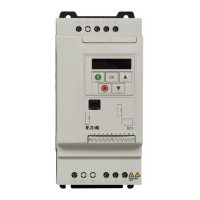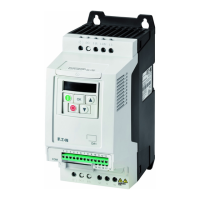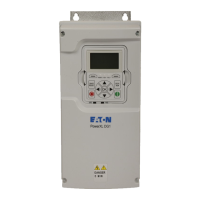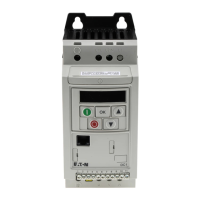2 Engineering
2.5 Motor
DC1 variable frequency drive 12/13 MN04020003Z-EN www.eaton.com 37
2.5 Motor
2.5.1 Motor Selection
General recommendations for motor selection:
• For a frequency-controlled magnet system (PDS), use three-phase AC
motors with squirrel-cage rotors and surface cooling, also known as
three-phase asynchronous motors or standard motors. Other types of
motors, such as external rotor motors, wound-rotor motors, reluctance
motors, permanent-magnet motors, synchronous motors, and servomo-
tors can also be operated with a variable frequency drive, but normally
require additional engineering in consultation with the motor's manufac-
turer.
• Only use motors that have insulation class F (maximum steady state
temperature of 155 °C ) at least.
• Choose 4 pole motors preferably (synchronous speed: 1500 min
-1
at 50 Hz and 1800 min
-1
at 60 Hz).
• Take the operating conditions into account for S1 operation (IEC 60034-1).
• When operating multiple motors in parallel on one variable frequency
drive, the motor output should not be more than three power classes
apart.
• Ensure that the motor is not overdimensioned. If it is underdimensioned
in the "speed control" (slip compensation) operating mode, the motor
output may only be one single assigned output level lower.
2.5.2 Parallel connection of motors
DC1 variable frequency drives make it possible to run several motors in
parallel in "V/Hz control" mode (P-10 = 0).
Parallel operation at different motor speeds can be implemented only by
changing the number of pole pairs and/or changing the motor’s transmission
ratio.
Connecting motors in parallel reduces the load resistance at the variable
frequency drive output. The total stator inductance is lower and the leakage
capacity of the lines greater. As a result, the current distortion is greater than
in a single-motor circuit.
In order to reduce the amount of current distortion, a motor choke should be
used at the variable frequency drive's output ( Table 34, page 218 and
Table 35, page 218).
→
If several motors are connected, the total of the motor currents,
taking the inrush currents into account (only when the motor is
connected during ongoing operation), must be less than the vari-
able frequency drive's rated operational current.

